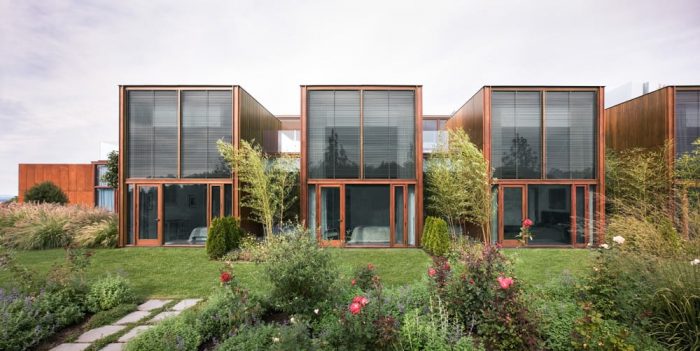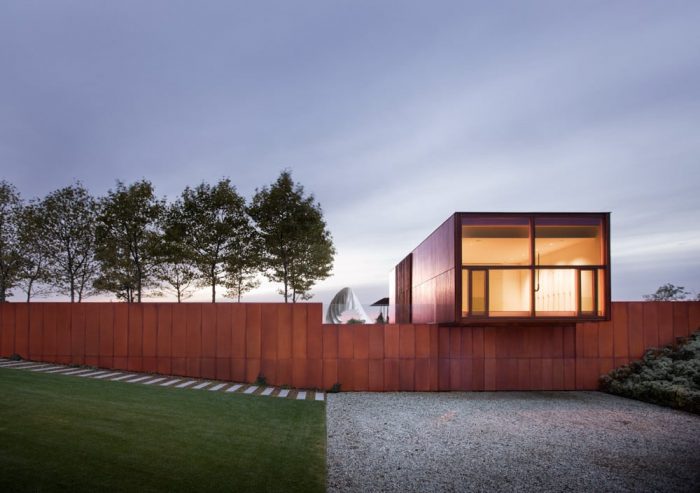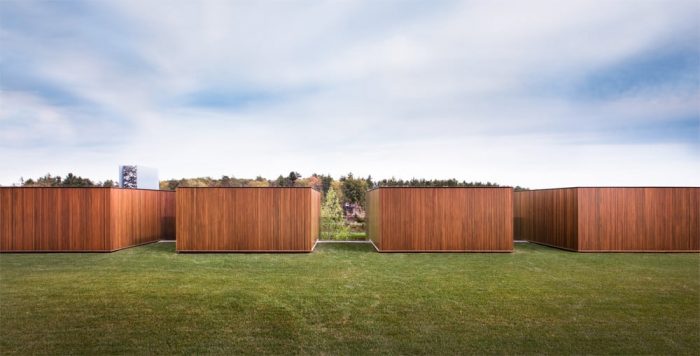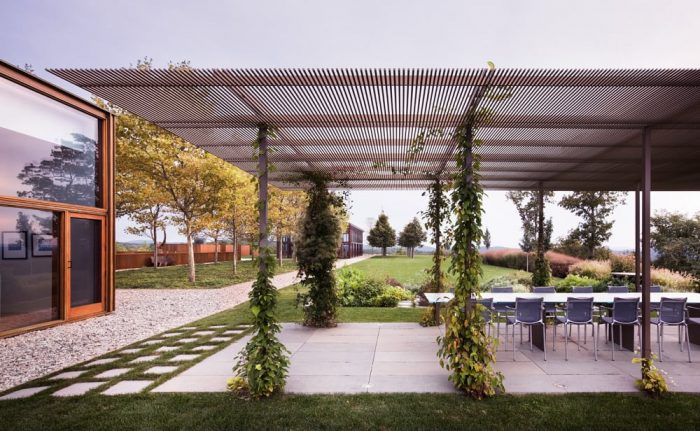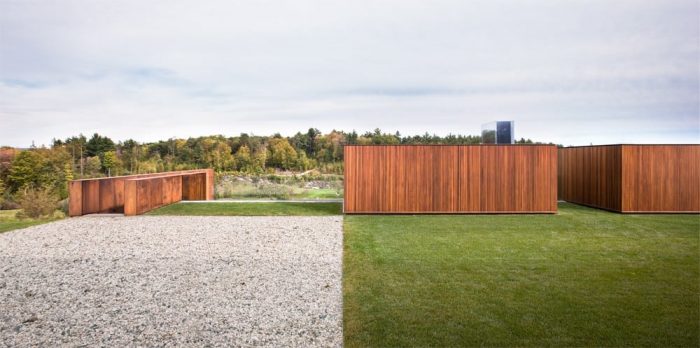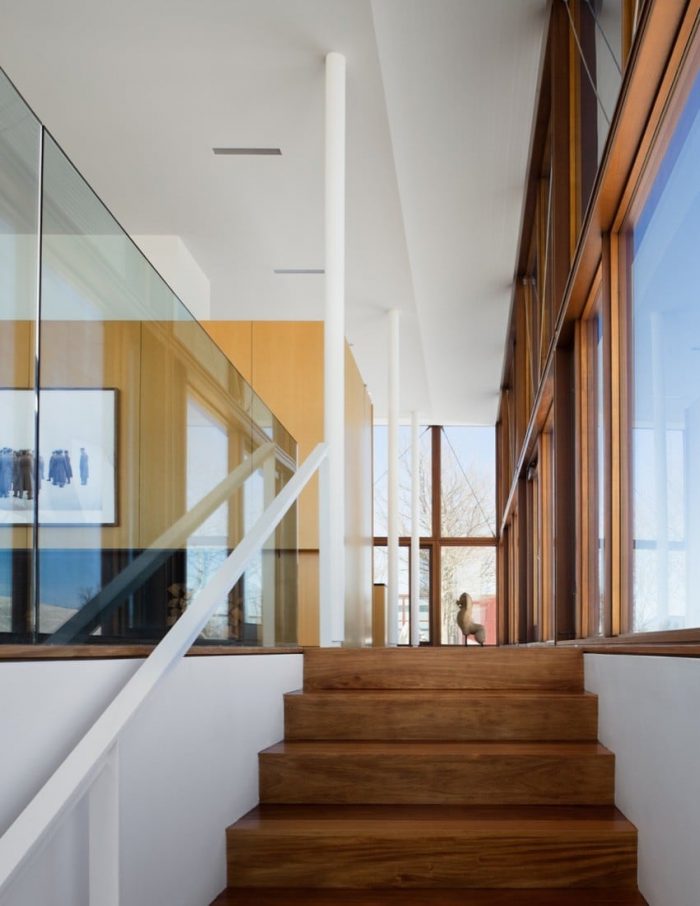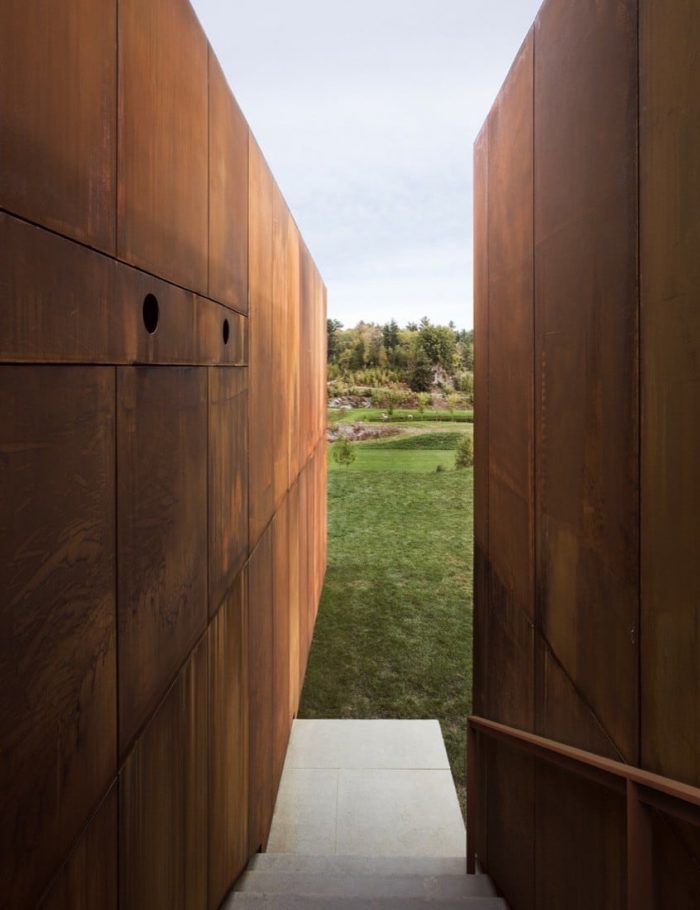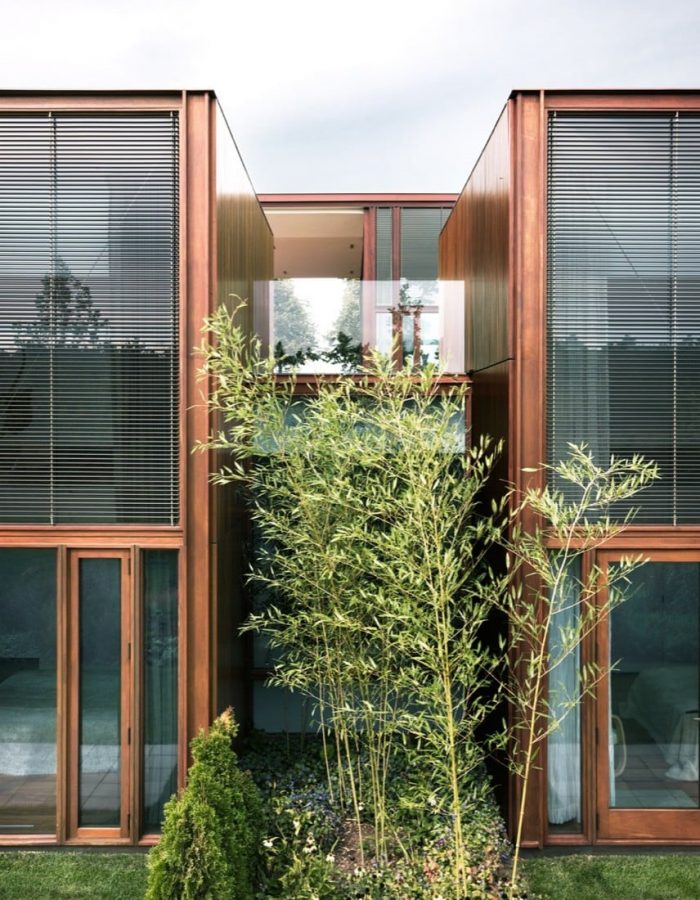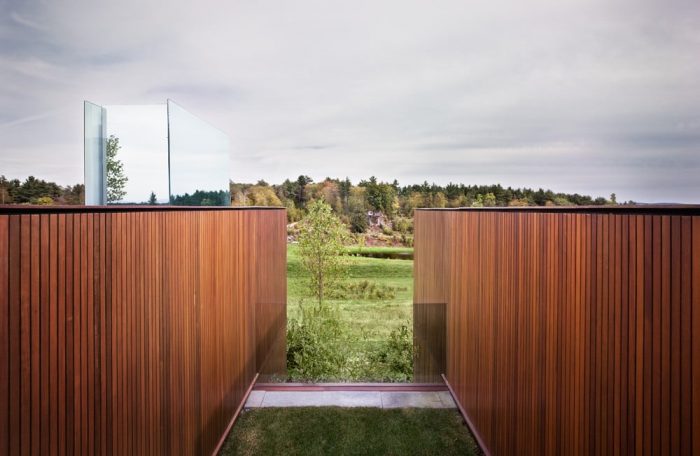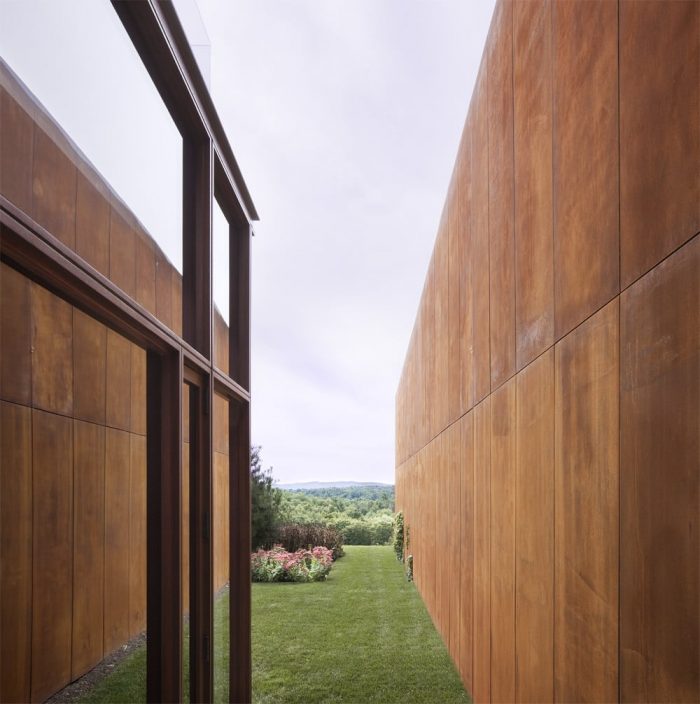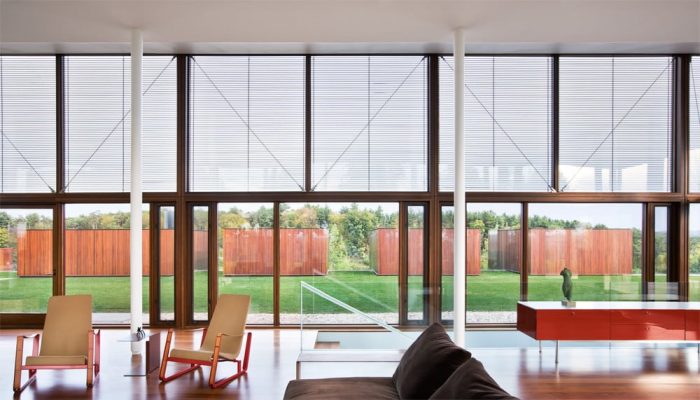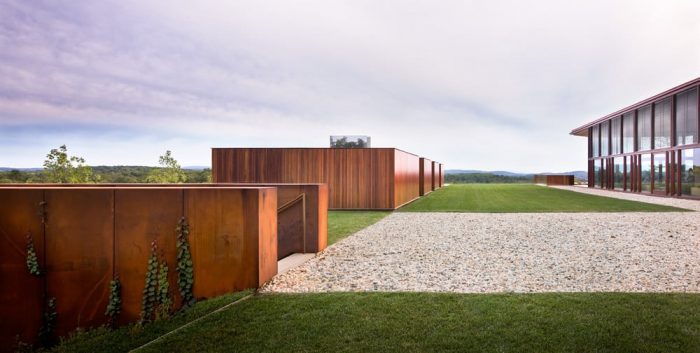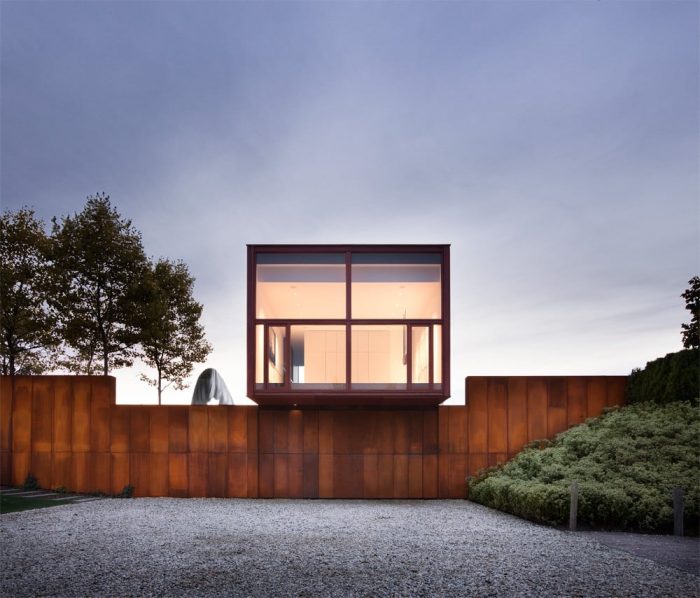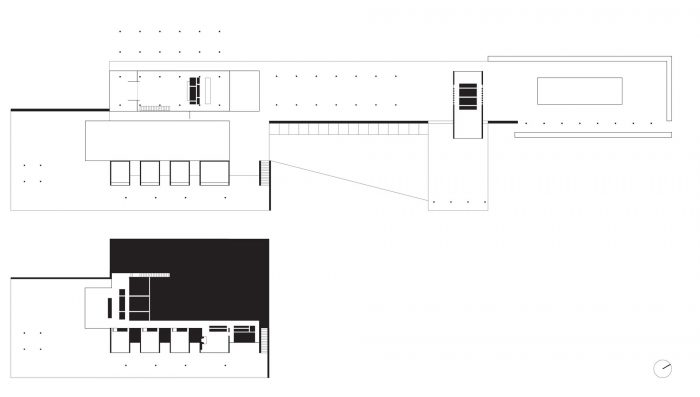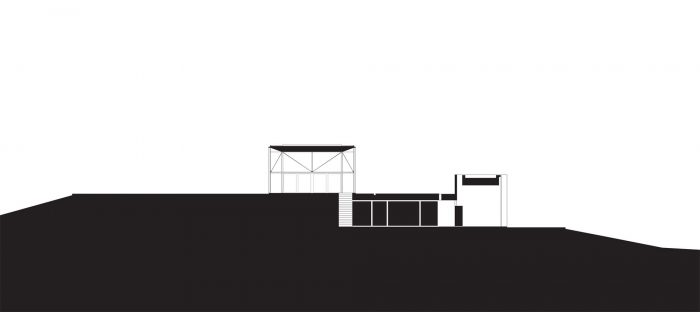抵达米尔布鲁克别墅的旅程是一个不急不缓的上升过程,重点是体验和重新体验土地。在这片200英亩的土地上,一个由离散的几何物体组成的建筑镶嵌在一个英雄般的景观中,编排着路线,调解着一连串展开的门槛和景观。沿着一条漫无边际的车道,穿过一片森林,来到一个小型的碎石停车场,然后转到一条人行道,沿着山脊上升。在精神上,这种进展让人想起了通往古希腊神庙的那条看似蜿蜒曲折却又巧妙安排的道路,让游客参与到比建筑本身更神圣的景观中。
The journey of arrival at the Millbrook House is an unhurried ascent, focused on experiencing and re-experiencing the land. On this 200-acre site, an architecture of discrete geometric objects set within a heroic landscape choreographs the route, mediating an unfolding sequence of thresholds and views. Up a rambling drive, through a forest to a small, gravel car park, the approach shifts to a footpath, rising along a hill’s ridge. In spirit, the progression recalls the seemingly meandering, yet deftly orchestrated path to an Ancient Greek temple, engaging the visitor with a landscape held even more sacred than the building itself.
在米尔布鲁克,第一眼看到的建筑形式是一个悬臂式的风化钢箱,即宾馆,悬停在停车场的边缘。深红色的镀金钢板构成了一堵护墙,从工作室下面直接延伸到山上,以金属板的规律节奏上升,旁边是青石踏板,镶嵌在斜坡上,就像一池水的踏脚石。
At Millbrook, the first glimpse of built form is a cantilevered, weathering-steel box, the guesthouse, hovering over an edge of the car park. Deep red, patinated steel panels form a retaining wall, extending from beneath the studio straight up hill, rising with the regular rhythm of metal plates beside bluestone treads, set into the slope like stepping stones on a pool of water.
上升到山顶,一个长满青草的海角,一侧是一个长方形的玻璃亭子,另一侧是一系列低矮的、带有桃花心木护套的体量,就像极简主义的雕塑一样,在其几何重复中纯净而精炼。这种围绕着空地的安排框住了哈德逊河谷的长长的视角,让人想起托马斯-杰斐逊的弗吉尼亚大学和路易斯-卡恩的索尔克研究所的视野捕捉的姿态。
The ascent reaches the hill’s crest, a grassy promontory, flanked by a rectangular glass pavilion along one side and, on the opposite edge, a series of four low, mahogany-sheathed volumes—as pure and distilled in their geometric repetition as a Minimalist sculpture. This arrangement around the clearing frames long, perspectival views of the Hudson Valley, reminiscent of the vista-capturing gestures of Thomas Jefferson’s University of Virginia and Louis Kahn’s Salk Institute.
米尔布鲁克的玻璃馆坐得很轻,透明度很高,它的地板似乎不受周围草坪的干扰。一旦你跨过门槛,进入起居室-餐厅-厨房的空间,就会看到全景式的、戏剧性的、全方位的视野。
The glass pavilion at Millbrook sits so lightly and with such transparency that its floor seems to flow uninterrupted from the surrounding carpet of lawn. Once you’ve crossed the threshold, into the living-dining-kitchen space, full panoramic views open up, dramatically and in all directions.
这种清晰的体量与木头包覆的巨石相映成趣,从一开始就没有窗户,其不透明的桃花心木外壳与风化的钢铁的丰富的土色相呼应。虽然看起来是独立的,但这个亭子和它的木头对应物都在室内,在草场下面连接起来。每个红木盒子都有一部分嵌入到倾斜的地形中,形成了一个用于睡觉和洗澡的私人小屋,进入玻璃亭子下面的一层。这些高顶的小木屋就像从地里冒出来的一样,与景观有一种亲密的关系。与视觉上广阔的山顶栖息地相对应,它们只向东开放,迎着清晨的阳光,每个人都有自己的竹园和外面的草地。
This clear volume plays against the wood-clad monoliths, windowless from the approach, their opaque, mahogany shells echoing the rich, earthy hues of the weathered steel. Though seemingly freestanding, the pavilion and its wood counterparts all connect indoors, beneath the grassy precinct. Each mahogany box, partially embedded in the sloping terrain, forms a private cabin for sleeping and bathing, entered one level below the glass pavilion. As if emerging from the earth, these high-ceilinged cabins have an intimate rapport with the landscape. In counterpoint to the visually expansive hilltop perch, they open only eastward, to the morning sun, each to its own bamboo garden and the meadows beyond.
你对房子和场地的感知在不断变化:不仅仅是当你穿过土地时,也是当你在室内移动时,从宏伟的公共区域到安静的私人区域。在外面,当你爬上山头,跨过高高的草坪时,这种体验会达到顶峰。但只有当你冒险进入玻璃馆时,旅程才达到高潮,从封闭的空间到广阔的景观。
Your perception of the house and site evolve: not simply as you cross the land, but also as you move through the interior, from grand communal to quieter private zones. Outside, the experience crescendos as you crest the hill and step across the high lawn. But only when you venture into the glass pavilion does the journey reach its climax, from contained space opening to the vastness of the landscape.
Architects: Thomas Phifer and Partners
Area : 6600 ft²
Year : 2010
Photographs :Scott Frances
City:MILLBROOK
Country: UNITED STATES


